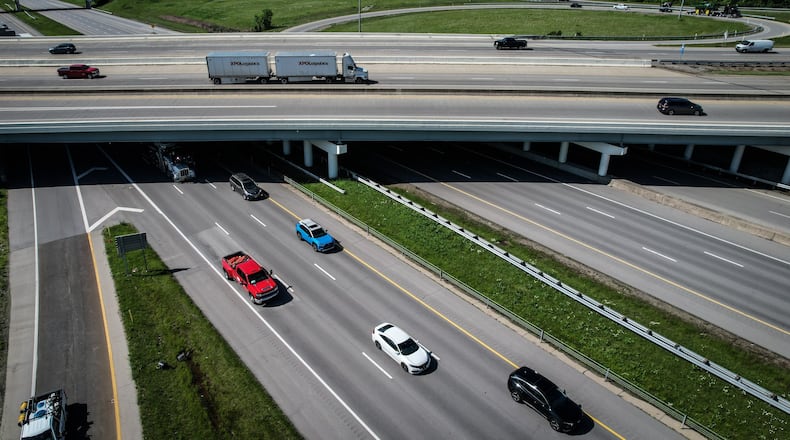“We continue to see robust travel across all modes of transportation,” AAA Public Affairs Manager Kara Hitchens told this news outlet. “We expected there would be great interest with the holiday falling on a Friday. It gives travelers an opportunity to extend their time off by using time off along with the holiday and the weekend.”
AAA said its Independence Day forecast includes two weekends instead of one to better reflect the flow of holiday travelers.
Ohio is expected to see nearly 3.5 million people travel over the holiday travel period, according to AAA.
Clark, Greene, Miami and Montgomery counties, defined by AAA as the Dayton Metro Area, will see more than 258,000 people travel, a 2.7% increase compared to 2024.
“Despite the continued uncertainty with the economy, people seem determined to travel,” Hitchens said. “We found that travelers will make adjustments to budgets to squeeze in time away. Whether it is a shorter period or scaling back a bit on plans, the holiday weekend still holds great meaning.”
This travel week also is expected to set a new record for the number of Americans hitting the road for the holiday.
AAA projects that 61.6 million people will travel by motor vehicle, an additional 1.3 million travelers compared to 2024 and much more than pre-COVID numbers in 2019, when 55.3 million people traveled by car.
Ohio will see more than 3.1 million people travel by motor vehicle, nearly 83,000 more than 2024. The Dayton Metro Area will see nearly 233,000 people travel by vehicle, a 2.5% increase compared to 2024.
The good news for many Americans is that has prices this summer are lower than a year ago nationwide.
As of Friday, the national average for a gallon of unleaded gas was $3.21, down from $3.50 a year ago, according to AAA. In Ohio, the average for a gallon of gas was $3.03 Friday, down from $3.57 a year earlier.
That downward trend also followed in Dayton ($2.89 in 2025 versus $3.59 in 2024), Springfield ($2.85 from $3.60) and Cincinnati ($3 from $3.62).
The busiest days for travel by car are predicted to be Wednesday and Sunday with afternoon hours being the most congested, according to INRIX, a provider of transportation data and insights.
INRIX suggests drivers should start their journey in the morning to avoid the worst traffic.
This news outlet asked Southwest Ohio residents what travel hack they use to make their drive or flight a bit easier.
Kristine McDaniel of Kettering said her family eats peanut butter-and-jelly sandwiches and fruit for lunches and packs oatmeal for a cheap, easy breakfast.
“The only meal we buy is dinner,” McDaniel said. “This makes travel cheaper for us, but we also lose weight.”
Lisa Ertel’s advice was succinct: “Travel at night with kids,” the Washington Twp. resident said, adding that the one thing she never travels without is a paper map.
Wes Trainum of Urbana Twp. said his advice is to “pack patience and respect.”
“Remember, when things go wrong, whether it’s traffic or an airline employee, treat others with respect,” he said.
When flying for work or for fun, Trainum said he always makes sure to download the latest airline apps or offline maps for his travels.
AAA is also reminding drivers not to be distracted.
“Phones should be set to ‘do not disturb,’” Hitchens said. “Set the navigation, climate control and infotainment controls before leaving the driveway. Instead of going through a fast-food drive-through, take a break from the road and go inside the restaurant to eat. Not only will that cut down on driving fatigue, but it will also keep food and beverage from becoming a distraction.”
Travel by air
AAA projects more than 5.8 million Americans will fly to their destinations. That’s an increase of nearly 1.4% compared to last year.
In Ohio, 120,289 residents are expected to fly to their destination, just a bit less than the 121,449 reported in 2024. the Dayton Metro Area is predicted to find nearly 9,600 people traveling by airplane, down 1.2% compared to 2024.
AAA expects 4.78 million people will travel by bus, cruise, or train this weekend, a 7.4% increase over last year and just below the record of the 2019 record of 4.79 million.
In Ohio, those other modes of transportation are up near pre-pandemic numbers with nearly 208,000 people expected to take a bus, cruise or train over the long weekend, breaking a previous record set in 2019. The Dayton Metro Area is predicted to find nearly 9,600 people traveling by those “other” modes of transportation, up 7.3% compared to 2024.
About the Author

